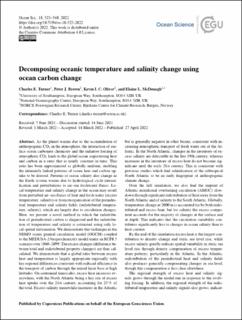| dc.contributor.author | Turner, Charles E. | |
| dc.contributor.author | Brown, Peter J. | |
| dc.contributor.author | Oliver, Kevin I. C. | |
| dc.contributor.author | McDonagh, Elaine Louise | |
| dc.date.accessioned | 2023-09-20T07:44:30Z | |
| dc.date.available | 2023-09-20T07:44:30Z | |
| dc.date.created | 2022-09-30T13:35:34Z | |
| dc.date.issued | 2022 | |
| dc.identifier.citation | Ocean Science. 2022, 18 (2), 523-548. | en_US |
| dc.identifier.issn | 1812-0784 | |
| dc.identifier.uri | https://hdl.handle.net/11250/3090667 | |
| dc.description.abstract | As the planet warms due to the accumulation of anthropogenic CO2 in the atmosphere, the interaction of surface ocean carbonate chemistry and the radiative forcing of atmospheric CO2 leads to the global ocean sequestering heat and carbon in a ratio that is nearly constant in time. This ratio has been approximated as globally uniform, enabling the intimately linked patterns of ocean heat and carbon uptake to be derived. Patterns of ocean salinity also change as the Earth system warms due to hydrological cycle intensification and perturbations to air–sea freshwater fluxes. Local temperature and salinity change in the ocean may result from perturbed air–sea fluxes of heat and fresh water (excess temperature, salinity) or from reorganisation of the preindustrial temperature and salinity fields (redistributed temperature, salinity), which are largely due to circulation changes. Here, we present a novel method in which the redistribution of preindustrial carbon is diagnosed and the redistribution of temperature and salinity is estimated using only local spatial information. We demonstrate this technique in the NEMO ocean general circulation model (OGCM) coupled to the MEDUSA-2 biogeochemistry model under an RCP8.5 scenario over 1860–2099. The excess changes (difference between total and redistributed property changes) are thus calculated. We demonstrate that a global ratio between excess heat and temperature is largely appropriate regionally with key regional differences consistent with reduced efficiency in the transport of carbon through the mixed layer base at high latitudes. On centennial timescales, excess heat increases everywhere, with the North Atlantic being a key site of excess heat uptake over the 21st century, accounting for 25 % of the total. Excess salinity meanwhile increases in the Atlantic but is generally negative in other basins, consistent with increasing atmospheric transport of fresh water out of the Atlantic. In the North Atlantic, changes in the inventory of excess salinity are detectable in the late 19th century, whereas increases in the inventory of excess heat do not become significant until the early 21st century. This is consistent with previous studies which find salinification of the subtropical North Atlantic to be an early fingerprint of anthropogenic climate change. Over the full simulation, we also find the imprint of Atlantic meridional overturning circulation (AMOC) slowdown through significant redistribution of heat away from the North Atlantic and of salinity to the South Atlantic. Globally, temperature change at 2000 m is accounted for by both redistributed and excess heat, but for salinity the excess component accounts for the majority of changes at the surface and at depth. This indicates that the circulation variability contributes significantly less to changes in ocean salinity than to heat content. By the end of the simulation excess heat is the largest contribution to density change and steric sea level rise, while excess salinity greatly reduces spatial variability in steric sea level rise through density compensation of excess temperature patterns, particularly in the Atlantic. In the Atlantic, redistribution of the preindustrial heat and salinity fields also produces generally compensating changes in sea level, though this compensation is less clear elsewhere. The regional strength of excess heat and salinity signals grows through the model run in response to the evolving forcing. In addition, the regional strength of the redistributed temperature and salinity signals also grows, indicating increasing circulation variability or systematic circulation change on timescales of at least the model run. | en_US |
| dc.language.iso | eng | en_US |
| dc.rights | Navngivelse 4.0 Internasjonal | * |
| dc.rights.uri | http://creativecommons.org/licenses/by/4.0/deed.no | * |
| dc.subject | Storskala havsirkulasjon | en_US |
| dc.subject | Large‐scale oceanic circulation | en_US |
| dc.title | Decomposing oceanic temperature and salinity change using ocean carbon change | en_US |
| dc.title.alternative | Decomposing oceanic temperature and salinity change using ocean carbon change | en_US |
| dc.type | Peer reviewed | en_US |
| dc.type | Journal article | en_US |
| dc.rights.holder | © Author(s) 2022 | en_US |
| dc.description.version | publishedVersion | en_US |
| cristin.ispublished | true | |
| cristin.fulltext | original | |
| cristin.qualitycode | 1 | |
| dc.identifier.doi | 10.5194/os-18-523-2022 | |
| dc.identifier.cristin | 2057231 | |
| dc.source.journal | Ocean Science | en_US |
| dc.source.volume | 18 | en_US |
| dc.source.issue | 2 | en_US |
| dc.source.pagenumber | 523-548 | en_US |
| dc.relation.project | Andre: UK Research and Innovation: NE/L002531/1 and NE/P019293/1 | en_US |
| dc.subject.nsi | VDP::Matematikk og naturvitenskap: 400 | en_US |
| dc.subject.nsi | VDP::Mathematics and natural scienses: 400 | en_US |

